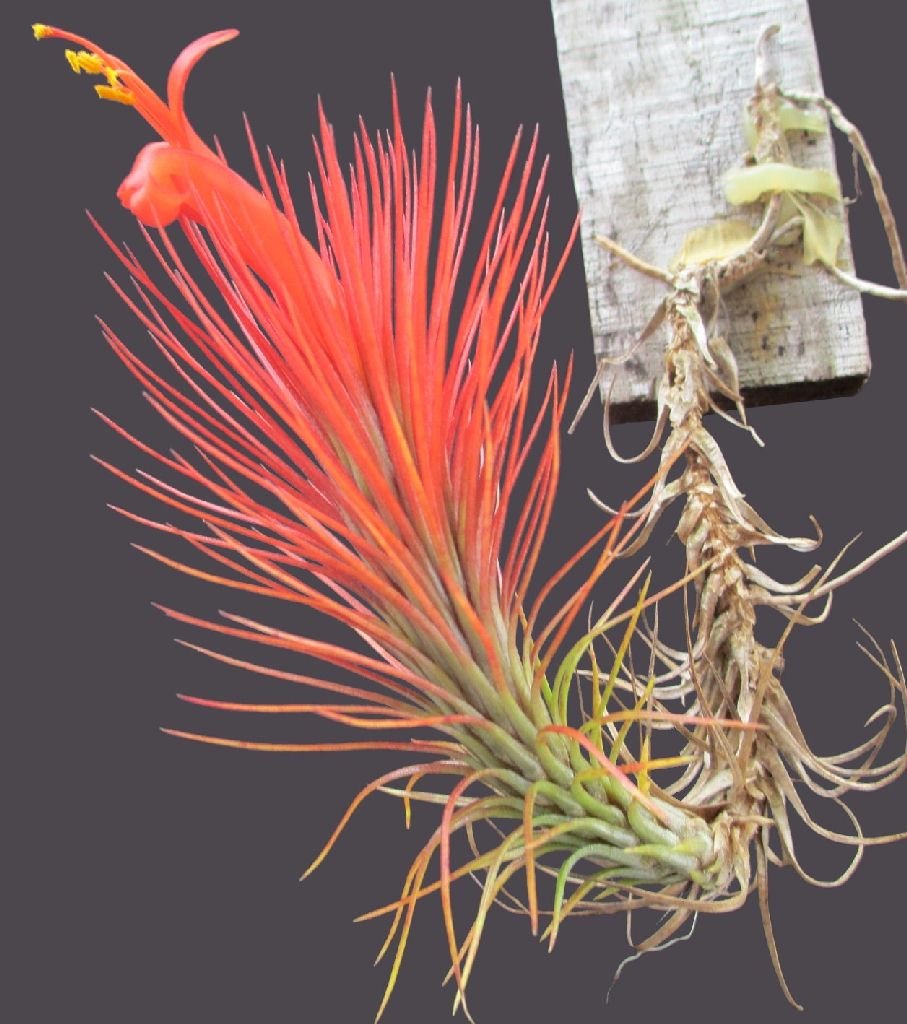
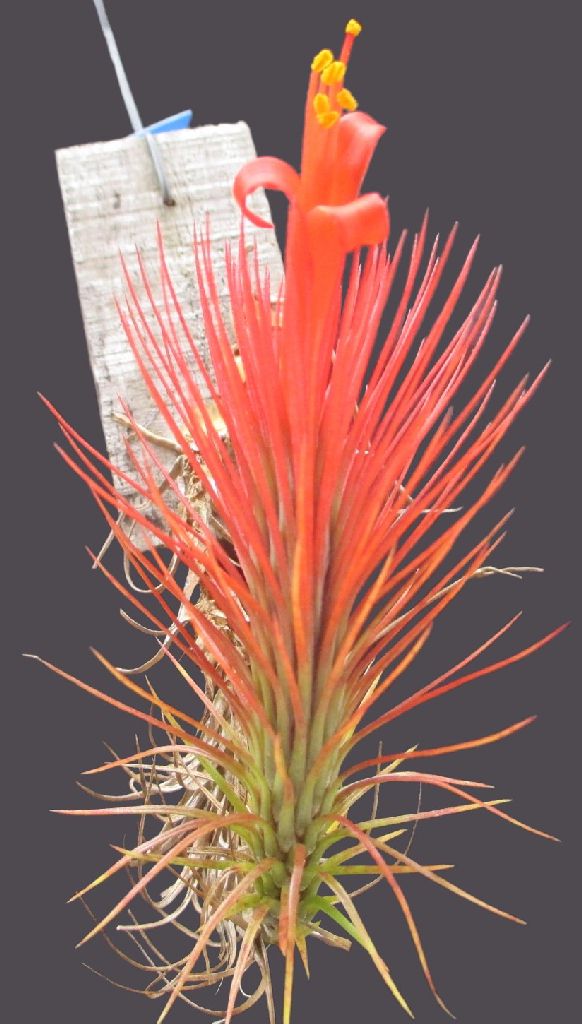

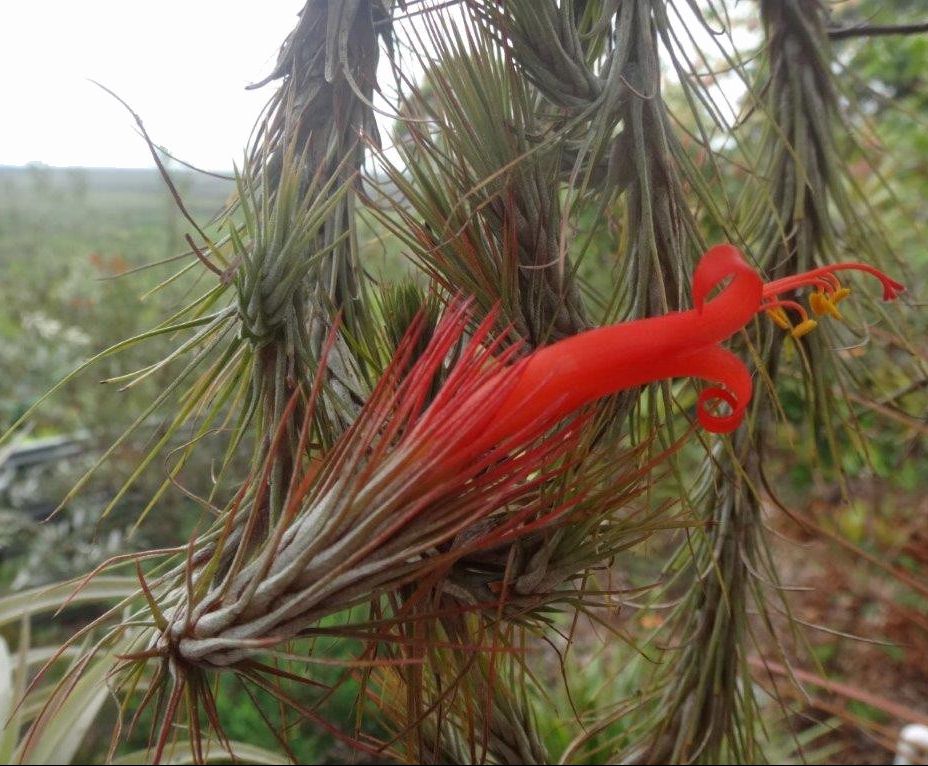
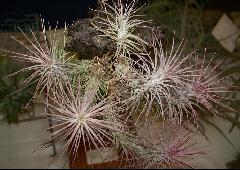
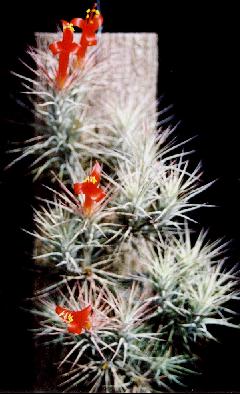
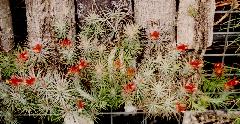

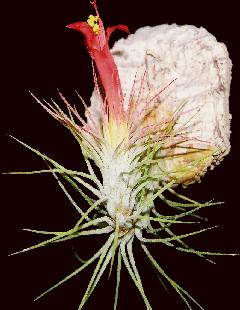

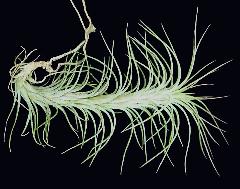
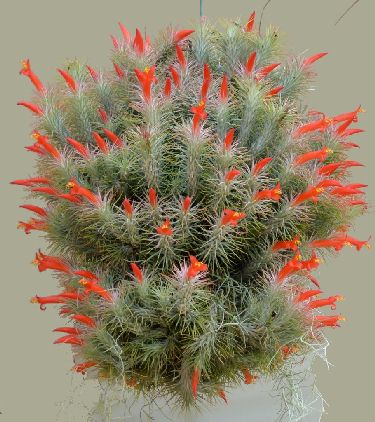

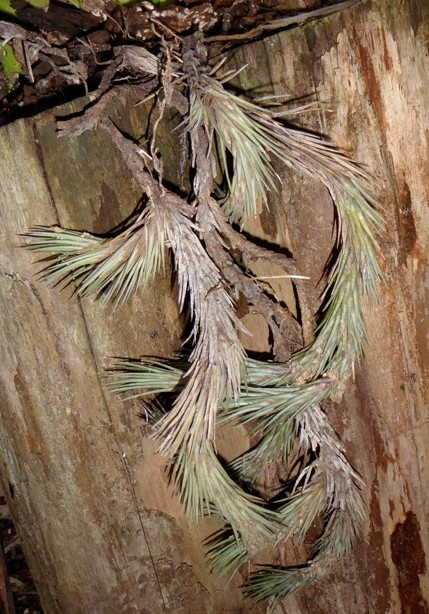

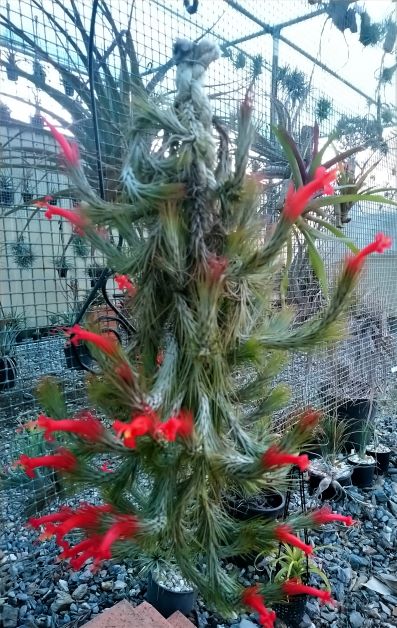
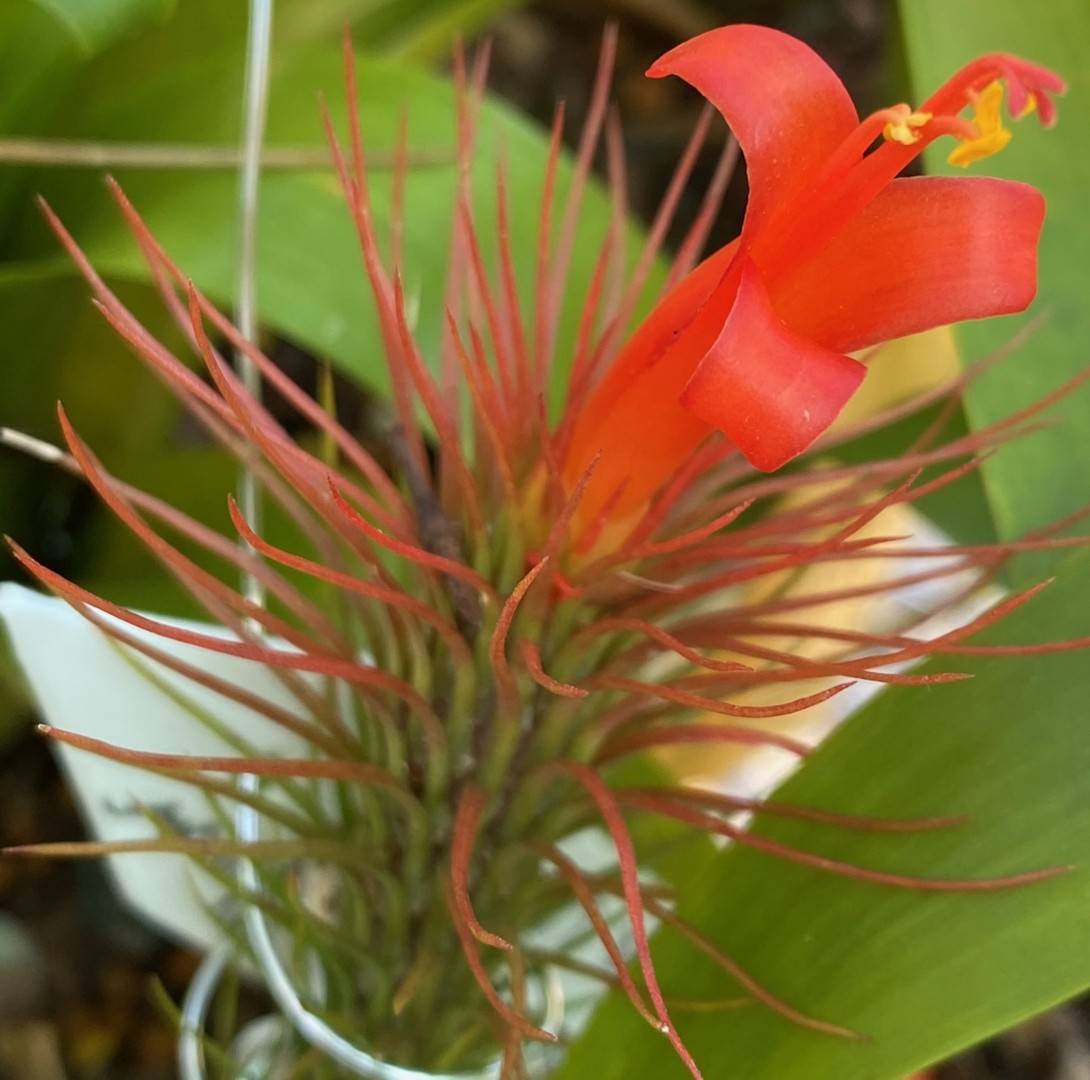

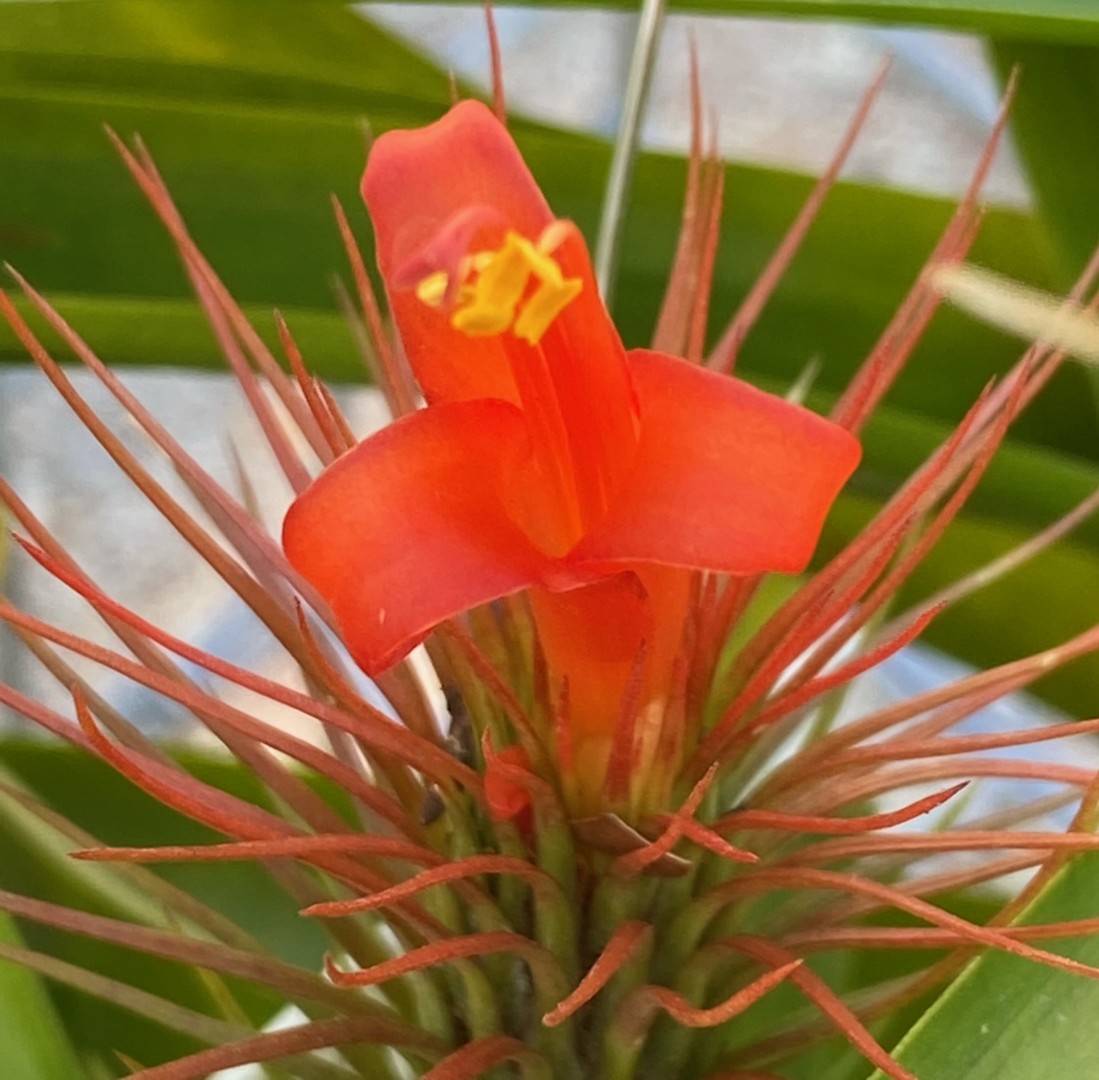
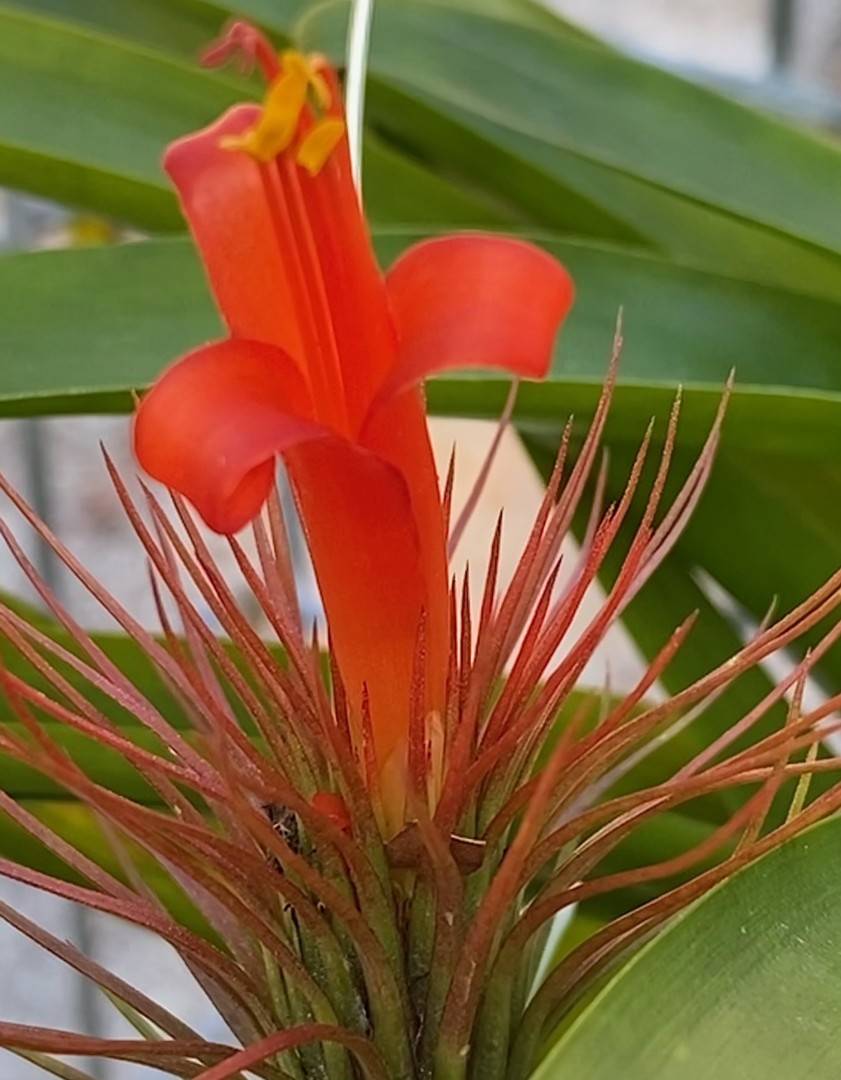


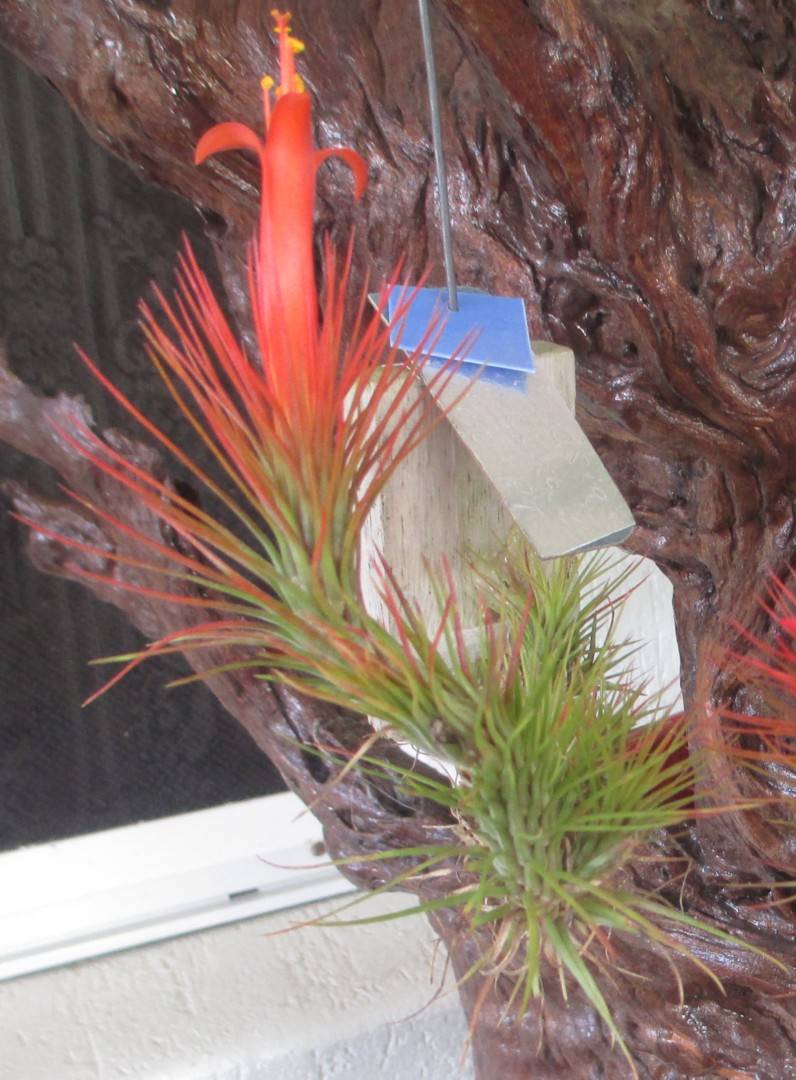


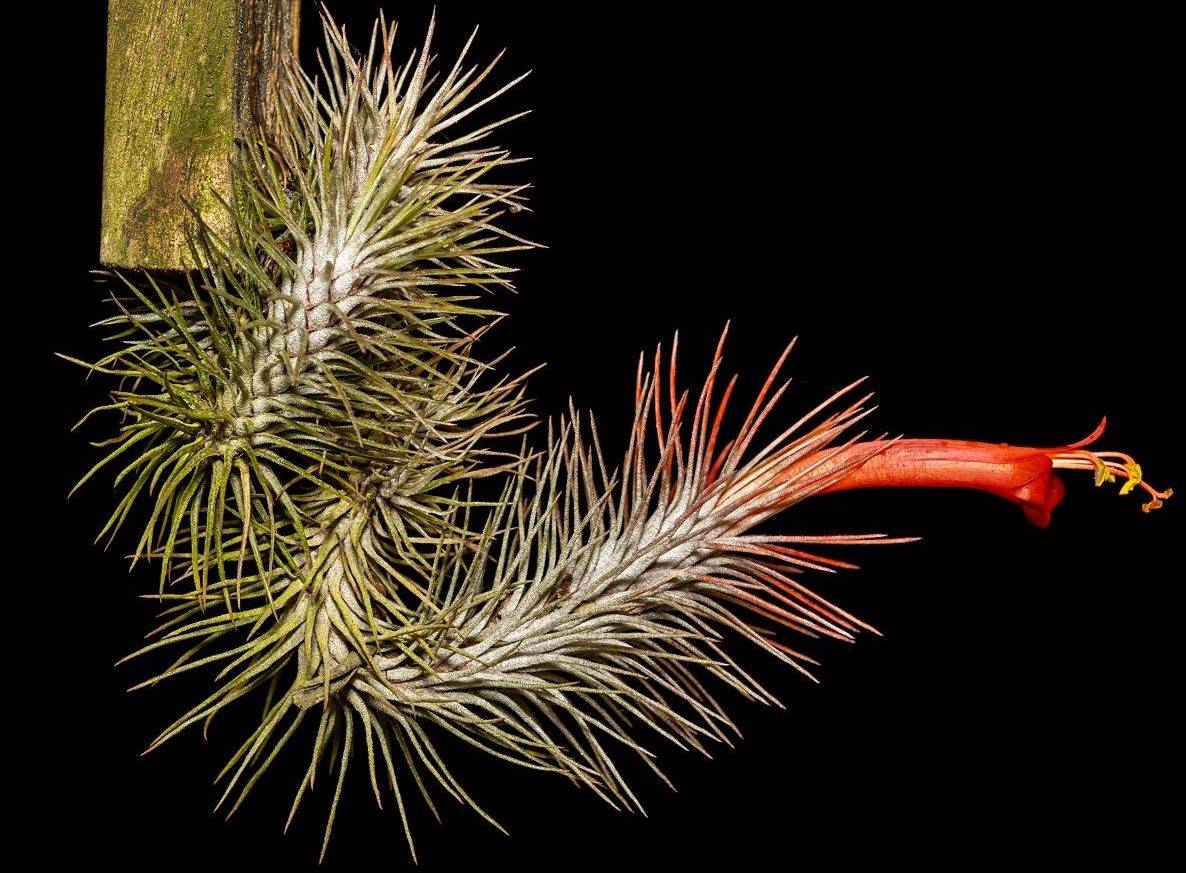


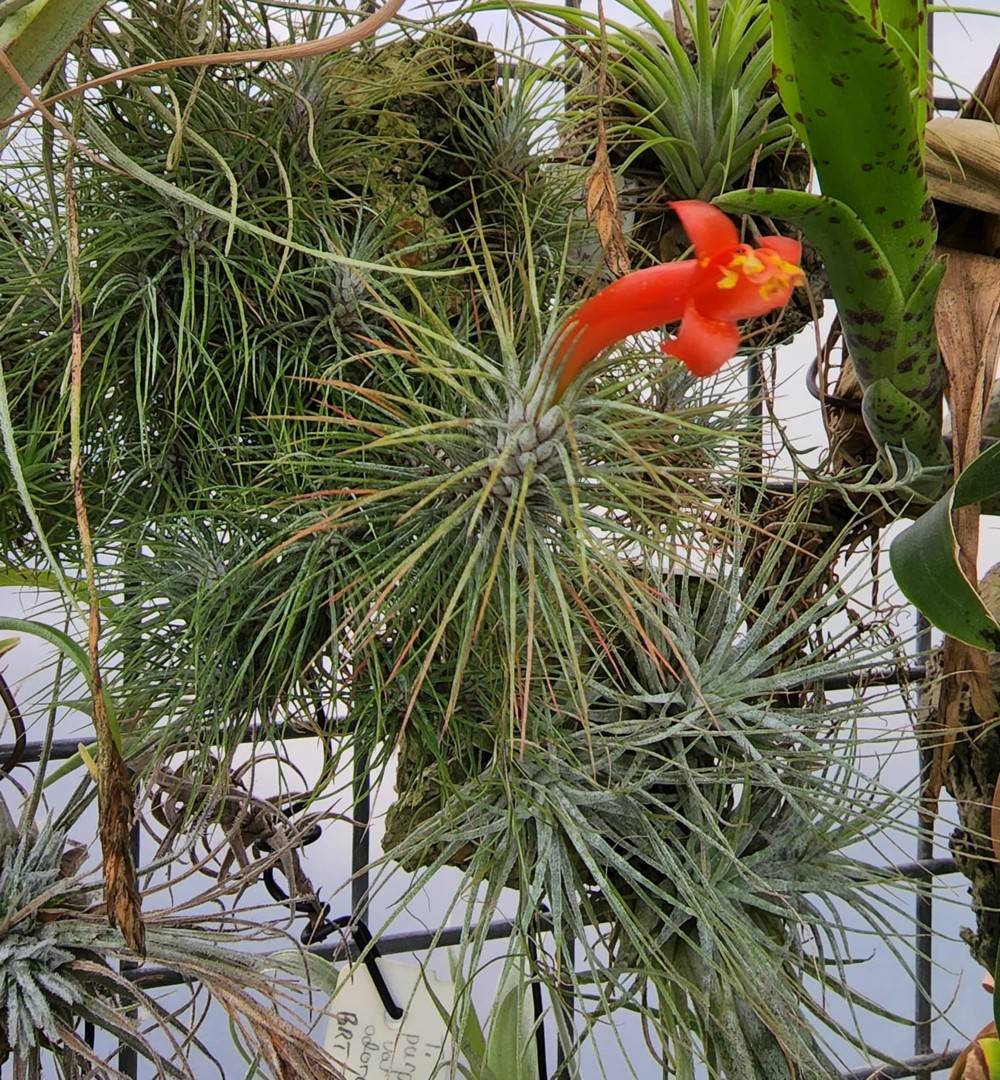
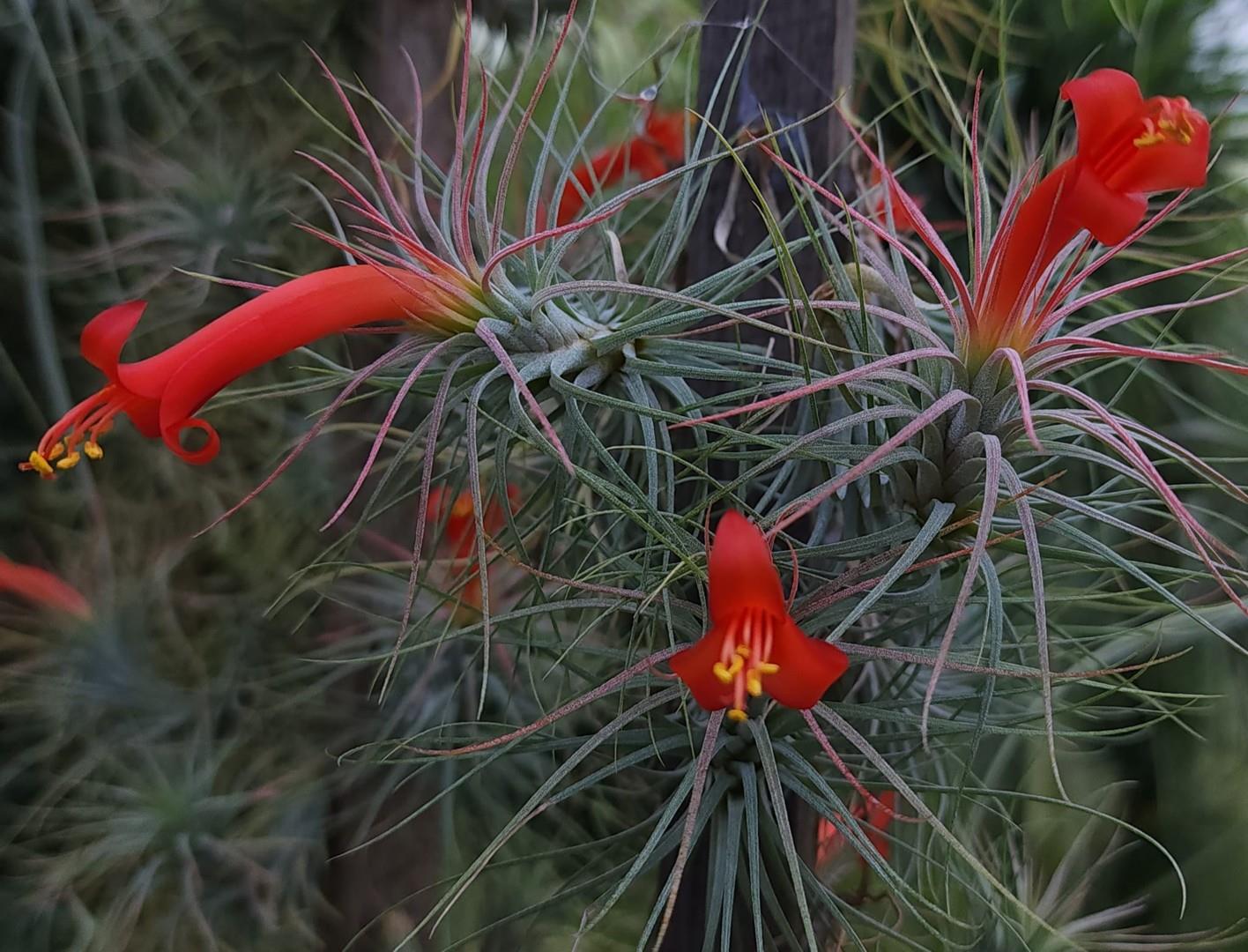
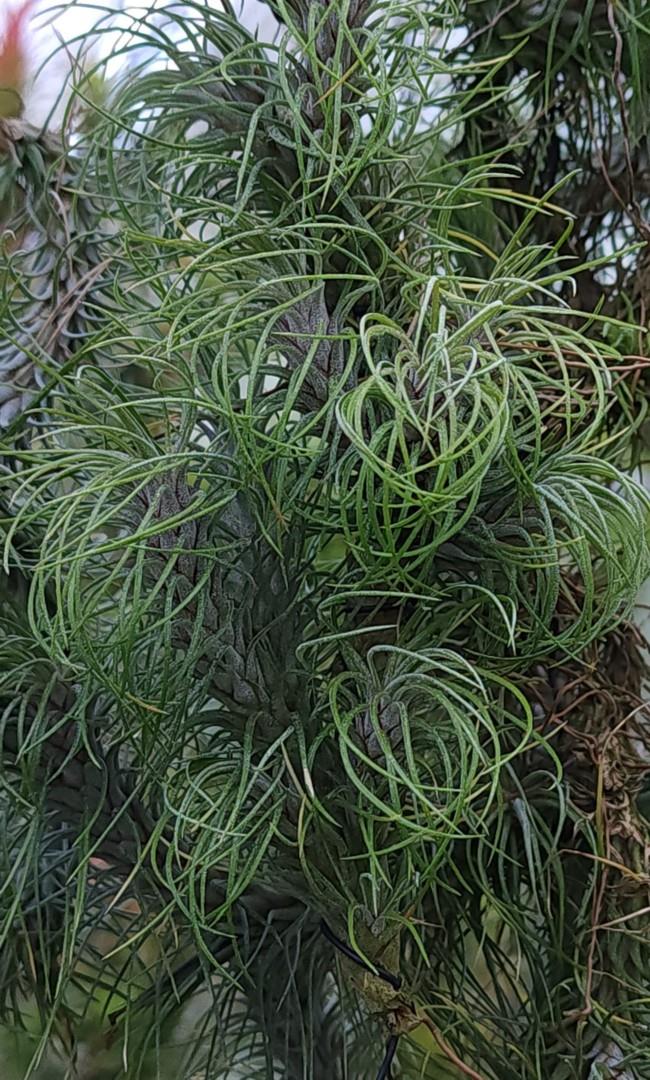
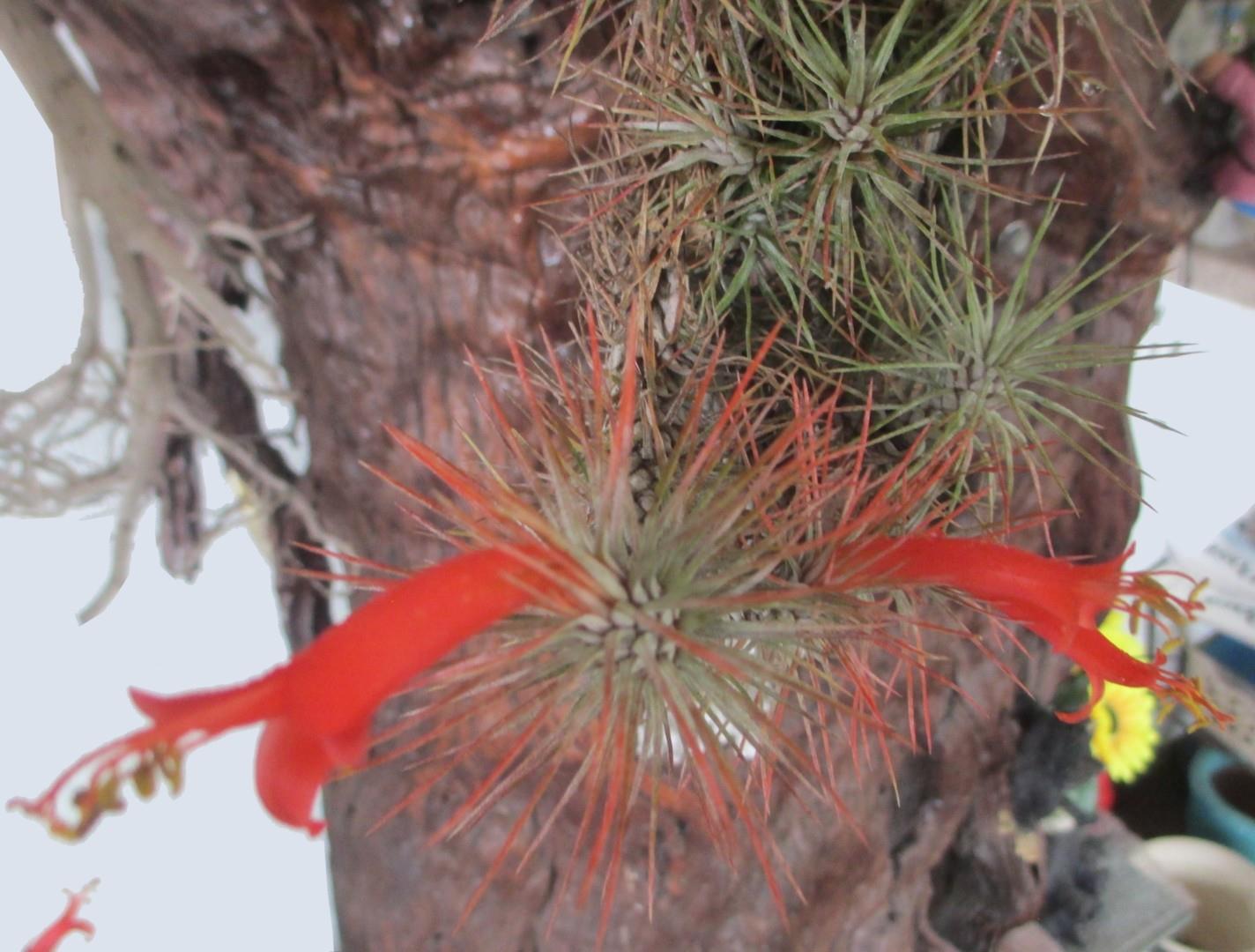
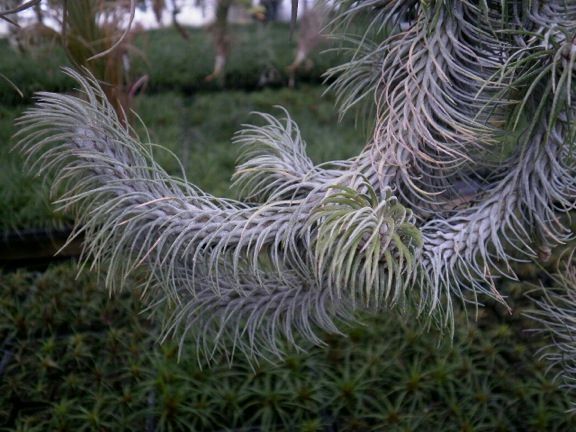

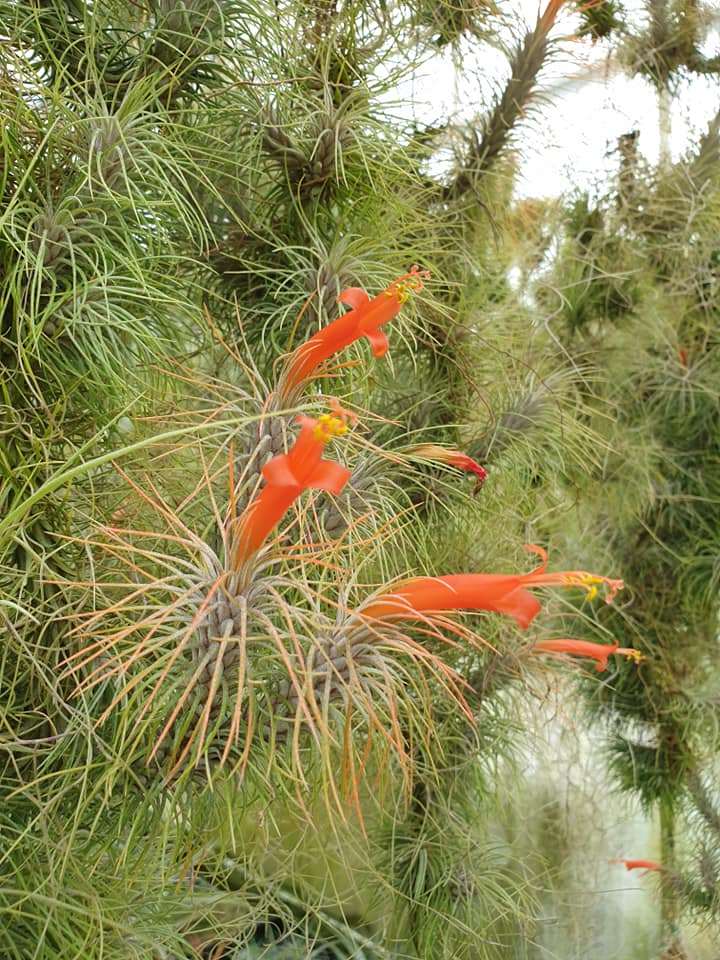

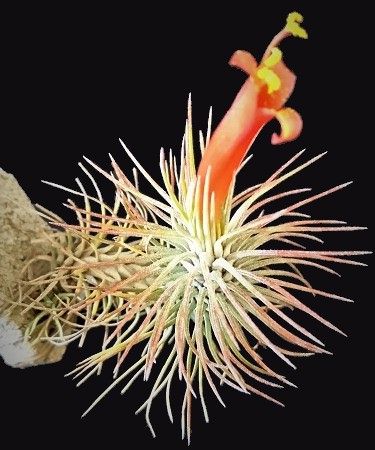
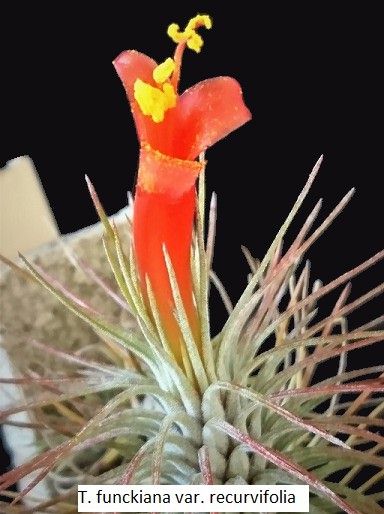
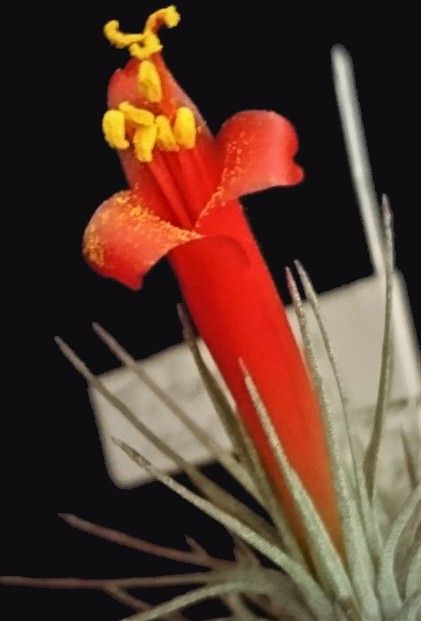


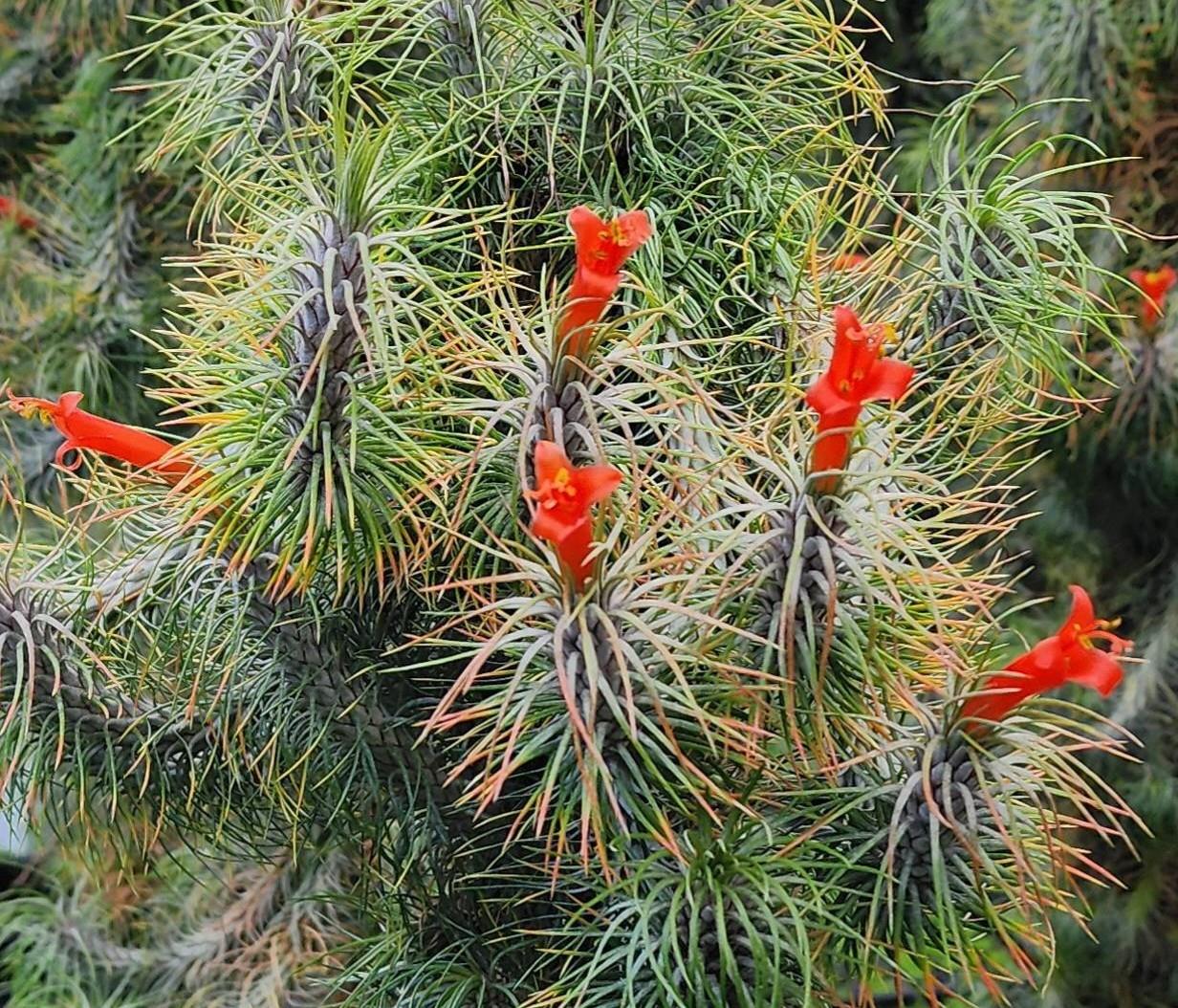

The following description is based on material collected in the dry valley of the Rio Chama, near the Puenta Real (southwest of Merida), Rauh 59051.
Plant long caulescent, richly branched and forming compact cushions, clumps or long clusters, often bright red from the influence of intensive sunshine.
Stems thin, seldom more than 5 mm thick, densely covered with spirally arranged leaves
Sheaths distinct, triangular ovate, 0.5 cm long, 0.5 cm wide, with adpressed, cinereous to brownish scales on both sides, glabrous and white at the base.
Blades erect to recurved, variable in their length, mostly up to 2.5 cm long, 2 mm wide, filiform-attenuate, strongly keeled below, apical leaves becoming bright red at flowering time
Inflorescence terminal, mostly con¨sisting of one single terminal flower, rarely two
Scape none;
upper leaves below the calyx pale, consisting mostly only of the sheath, forming a kind of involucrum below the flower; these up to 6 cm long (with the exserted stamens), erect, slightly zygomorphic
Sepals elliptic-ovate, up to 15 mm long, 6 mm wide, obtuse, free, chartaceous, pale green, ecarinate.
Petals lingulate, up to 5 cm long, recurved for 1 cm, bright red.
Filaments red, straight, curved at the apex;
style red, curved at apex with 3 spreading stigmas, these somewhat longer than the anthers.
Capsule 3-4 cm long.
Distribution. T. funckiana grows mostly on dry rock walls in the valley of the Rio Chama, near Merida, exposed to full sun. Enrique Graf, Caracas, found only one specimen growing as an epiphyte on trees in the region of Barinas. It is characterized by thick stems and silver-gray, spreading to recurved leaves.
Tillandsia funckiana Baker var. recurvifolia A. Blass ex Rauh var. nov. JBS 1989 p116
Differt a typo var . funckiana ramis crassis et foliis griseis valde recurvatis.
Stems very thick, densely covered with silver-gray leaves, strongly recurved in their upper half to one side.
Holotype. B.G .H. 64 587, in Herb. Inst. System. Bot. Univ. Heidelberg (HEID).
Distribution. Probably in the valley of the Rio Chama, Prov. Merida, Venezuela.
The variety recurvifolia A. Blass in cultivation forms big clumps and is lazy in producing flowers in the European climate.
Tillandsia andreana and Tillandsia funckiana compared. Text and illustrations by Werner Rauh in J. Brom. Soc. 39(3): 111-118. 1989
Two of the most beautiful and attractive small tillandsias, much favoured by amateurs and Tillandsia collectors, are Tillandsia andreana E. Morren ex Andre and T. funckiana Baker. The former was described by E. Morren and pictured in Andre's Bromeliaceae andreanae (Paris, 1889), plate XXIX B. The latter was published by J.G. Baker in his Handbook of the Bromeliaceae (London, 1889), page 196. In spite of these facts, L.B. Smith and R.J. Downs recognize only one species, namely T. andreana and regard T. funckiana as synonymous with it. Francisco Oliva follows with his beautiful book, Bromeliaceae of Venezuela (Caracas, 1987) and describes only T. andreana, but the accompanying photographs on page 214 and 215 show T. funckiana from Venezuela.
On the other hand, the well-known but prematurely deceased German tillandsia collector, Alfred Blass stated that Tillandsia andreana and T. funckiana are two different and distinct species. He published a note to that effect in the Journal of the Bromeliad Society 27(4): 160-2. 1977 but it seems that his note has been forgotten. Accordingly, we have decided to demonstrate once more the difference between the two species on the basis of material collected in Colombia in the type locality and in Venezuela in the dry valley of the Rio Chama near Merida and at Las Trincheras on the way to Puerto Cabello.
Tillandsia andreana is self-fertile. Andre himself, who discovered this beautiful species, did not see these plants in flower but only when they were in fruit. He put the plant into the subgenus Pitrophyllum (Beer) Baker (= subgen. Tillandsia), but according to the flower structure, T. andreana would fit traditionally in the subgenus Anoplophytum (Beer) Baker.
T. funckiana grows mostly on dry rock walls in the valley of the Rio Chama, near Merida, exposed to full sun. Enrique Graf, Caracas, found only one specimen growing as an epiphyte on trees in the region of Barinas. It is characterized by thick stems and silver-gray, spreading to recurved leaves.
Trincheras is a very isolated locality about 600 km by air from Merida on the way to Puerto Cabello, Prov. Carabobo, near the Caribbean Sea where it was first found in 1938 by Alston, no 5716. Enrique Graf re-collected the plant in the same locality and he reports that the locality, also dry rocks, is full of snakes. He has never seen so many snakes in Venezuela as in Las Trincheras.
In contrast with Tillandsia andreana, T. funckiana is self-sterile and when in cultivation produces fruits only with pollination by specimens of different clones. The flowers, typical hummingbird (colibri) flowers, last several days.
We conclude that Tillandsia funckiana and T. andreana are two different and distinct species belonging to two different subgenera: T. andreana to the subgenus Anoplophytum (stamens included with plicate filaments; style slender, longer than the ovary); T. funckiana to the subgenus Tillandsia (stamens and style long ex¨serted, filaments straight.
While Tillandsia andreana is very uniform and not variable concerning its habit and its growth form, T. funckiana is a very variable species. In the Heidelberg Botanical Garden, we cultivate forms with long and short leaves, forms with silver-gray leaf blades (densely lepidote) and some with green blades (with fewer scales) with thin and thicker stems (fig. 12). But these are only forms and not worth being described as distinct varieties; they all grow on rocks in the provinces of Merida and Carabobo.
There is one form, of which the locality is not known, that differs from all the other forms of T. funckiana by the strongly recurved leaves. It was named "recurvifolia" by A. Blass.
Tillandsia Andreana - Tillandsia Funckiana by ALFRED BLASS in J. Brom. Soc. 27(4): 160-2. 1977 (Translated by Walter Goddard)
Even the most competent taxonomist sometimes has a difficult time differentiating between two similar species. This is especially true when one is working exclusively with dry herbarium material, for the decision as to how to classify a "border case" depends more or less on the supposition of the nomenclator. Many species show forms of transmutation which make taxonomical decisions even more difficult, I have observed in my collection the following forms of transmutation:
T. caput-medusae and T. circinnata
T. purpurea, straminea, and cacticola
T. sphaerocephala, calocephala, and nana
T. incarnata and macbrideana
T. brachycaulos and capitata
T. concolor, acostae, and fasciculata
T. arequitae, boliviensis, and lorenziana
T. aurea, aureo-brunnea, and humilis
T. vernicosa and didisticha
Some of these plants, I believe, represent not separate species, but are just varieties. I would like to emphasize that the above mentioned transmutations are not hybrids nor are they artificial cross-pollinates. Serious collectors, who specialize in certain plant families, may be helpful to science by reporting their observations. I had the pleasure some years ago to show Dr. Lyman B. Smith the obvious differences between T. magnusiana and T. plumosa, which were originally registered as one single species.
With this article I would like to prove that T. andreana and T. funckiana are definitely two separate species.
For several years I have grown three different clones of T. funckiana, all of them coming from Venezuela. One of these plants is particularly beautiful, but regrettably is rather rare. This plant grows much larger than the standard form, and the leaves are strongly recurved. I would like to see this species named Tillandisa funckiana var. nov. recurvifolia.
I have two different clones of T. andreana under cultivation. One is distinguished by having leaves covered with silvery green scales. The other, being rather rare, has yellowish green leaves and shows fewer scales. T. andreana is found exclusively in Colombia, but the localities where the two different kinds come from are more than 1000 km apart. Mr. Thiken, an ardent plant collector, was the first one to discover these tillandsias and to introduce them to the European market.
All T. funckiana are strongly caulescent, whereas T. andreana never form stems. But the main difference between the two species becomes evident when one studies the stamens, which can be easily seen above the petals of T. funckiana, while they are completely recessed within the red petals of T. andreana.
As the differences in appearance are so obvious and no transmutations in nature have been discovered, I believe that we have here two separate species which might be somehow related.
In my estimation both plants represent some of the most beautiful of the miniature tillandsias. Their brilliant red bracts are extremely large for such small plants. At one time I had 36 flowers growing on a single branch of T. funckiana. Both species are prolific seed bearers, and seedlings grow well when protected from bright sun light.
I think that Mez was mistaken when he gave the habitat for T. funckiana as Merida in Colombia. Collectors who have worked in this area recently occasionally found T. andreana, but never T. funckiana. T. funckiana has been found at several locations in Venezuela, and, as mentioned above in different shapes and colors.
Both species are very much favored in Europe, as they are beautiful and elegant even when not in flower. As we who live in Europe have to grow our bromeliads exclusively in greenhouses, we greatly prefer those plants which are small in size.
From S&D
245. Tillandsia andreana E. Morren ex Andre, Enum. Bromel. 7. 13 Dec 1888; Revue Hort. 60: 567. 16 Dec 1888.
Pityrophyllum andreanum E. Morren ex Andre, E`num. Bromel. 7. 13 Dec 1888; Revue Hort. 60: 567. 16 Dec 1888; nomen in synon.
Tillandsia funckiana Baker, Handb. Bromel. 196. 1889. Type. Laderas de San Pablo near Merida, Venezuela, Funck & Schlim 1258 (BM, P), ca 1846.
Plant varying from the typically stemless phase to long-caulescent.
Leaves scarcely more than 5 cm long, covered throughout with appressed cinereous or brownish scales;
sheaths distinct, triangular-ovate, ca 5 mm long;
blades erect to recurved, linear, filiform-attenuate, 1-2 mm wide, strongly keeled below.
Scape none.
Inflorescence terminal, consisting of a single flower or rarely two.
Floral bract lance-oblong, acute, mem-branaceous, 1-nerved, glabrous, not more than half as long as the sepals.
Sepals elliptic-ovate, obtuse, 15 mm long, chartaceous, even, glabrous, free;
petals erect but more or less recurving at apex, slightly asymmetric as in Pitcairnia, to 44 mm long, red;
stamens and pistil exserted.
TYPE. Andre 1762 (holotype K, GH photo), Rio de la Honda, near the Bridge of Icononzo, Pandi, Cundinamarca, Colombia, Feb 1876.
DISTRIBUTION. Epiphytic and saxicolous, 600-1750 m alt, Colombia, Venezuela.
COLOMBIA. MAGDALENA: Manaure, 24 Aug 1946, Foster & Smith 1476 (GH). NORTE DE SANOETANDER: Gramalote (Cucuta), Dec 1940, Maria 2558 (COL, GH). TOLIMA: Rio Icononzo, 13 Oct 1946, Foster 1884 (GH). VENEZUELA. CARABOBO: Las Trincheras to Puerto Cabello, 27 Dec 1938, Alston 5716 (BM). MERIDA: El Morro, 14 Jan 1911, Jahn 78 (US); 13 May 1964, Trujillo 6346 (VEN); Rio Chama, 15 Apr 1922, Jahn 1088 (GH, NY, US); 31 Aug 1966, Steyermark & Rabe 96994 (US, VEN); Puente Real, 2 Feb 1928, Pittier 12846 (NY, US); 2 Dec 1952, Bernardi 134 (MER, NY); Lagunillas, 29 Apr 1944, Steyermark 56217 (GH); 22 Mar 1964, Trujillo 6183 (VEN); Merida, Jan 1950, Marcuzzi s n (US).
emails
From: Paul T Isley III
To: derek butcher
Subject: Re: funckiana
Date: Mon, 22 Jun 2009
Derek,
I did some research and got lucky. Nicolas Funck was a Belgian botanical explorer in the mid 19th century and a good friend of Edouard Morren. He also climbed Mt. Orizaba, Mexico's highest peak, in 1838.
Paul
Sturt Gibbs
Cairns Bromeliad Soc.Inc. April 2010.
Just a few forms of Tillandsia funckiana but note that only T. funckiana and T. funckiana var. recurvifolia are officially recognised
No.1 T. funckiana This form blushes red on the leaf tips when flowering and the leaves flare slightly at end of the plant and has a lipstick red flower
No 2 T. funckiana v recurvifolia this form blushes a slight pink when flowering and the leaves really recurve at the end of the plant
No 3 T. funckiana v recurvifolia grey form colours up slightly at tip when flowering
No 4 T. funckiana 'Giant' (recurvifolia) this plant is a very thick form and has a very dark red flower
No 5 T. funckiana 'Maron' this form is very close to the same form 'giant' but has a maroon blush to the stem and nice red flower
No 6 T. funckiana v stricta this form is a little different to the form funckiana as the leaf tips do not flare at the end of the plant
No 7 T. funckiana 'grey leafí this form clumps up nicely but very reluctant to flower
No 8 T. funckiana a small form from Neville Ryan
No 9 T. funckiana 'giant silver' does not colour up very much on flowering